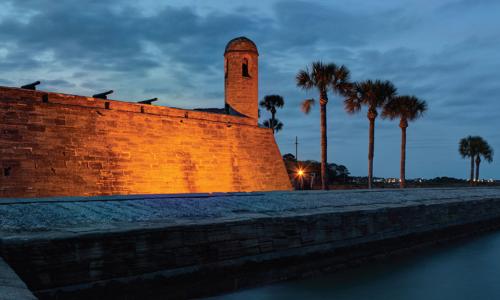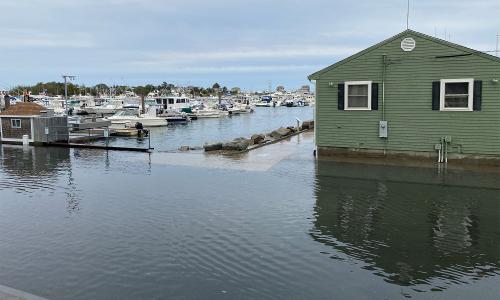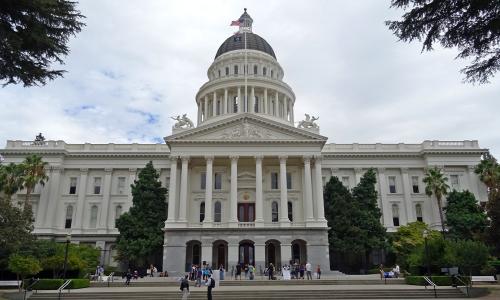Table of Contents
For three generations, the National Aeronautics and Space Administration (NASA) has stirred humans to think beyond our home planet and ponder our place in the universe. From the sight of the first people landing on the moon in 1969 to the awe-inspiring beauty of the cosmos beamed back as images from the Hubble Telescope, NASA has inspired us. But with more than two-thirds of its facilities within 16 feet of sea level, and many launch pads and other structures at very low elevations, NASA faces urgent challenges to protect itself from rising seas.
When the Soviet Union launched Sputnik, the first successful artificial satellite, in 1957, Americans were shocked at losing the first phase of the space race to their cold war rival, yet they were also exhilarated by the potential of space exploration. Impelled by this competition, NASA executed a series of manned space missions: Projects Mercury, Gemini, and Apollo. Further propelled by Soviet cosmonaut Yuri Gagarin’s first human flight into outer space, President John F. Kennedy vowed in 1962, “We choose to go to the moon in this decade.” And indeed, on June 20, 1969, Buzz Aldrin and Neil Armstrong became the first men to land on the moon, thrilling their fellow Americans as they walked on its surface for more than two hours and planted the Stars and Stripes. At the height of the cold war, NASA embodied American courage and innovation and spurred the country to higher scientific achievement.
Since the moon landing, NASA has carried out hundreds of missions, manned and unmanned, including the launch of a prototype space station (Skylab, in 1973). For 30 years, from 1981 to 2011, as the cold war waned and ended, the Space Shuttle Program solidified international cooperation in space. In 1990, NASA launched the Hubble Space Telescope, which takes extremely high-resolution images of deep space—and therefore of the universe’s past. The agency has made unmanned explorations of all the planets in our solar system, sampling ice on Mars, confirming temperatures on Venus, and discovering methane lakes on Saturn’s moon, Titan, and a possible subsurface ocean on Jupiter’s moon, Europa. NASA’s Hubble, Chandra, and Fermi observatories have revealed that enormous black holes, present in most galaxies, often emit powerful jets of matter traveling near the speed of light, thereby allowing physicists to test Einstein’s theories.
NASA yielded its launch of commercial satellites to the private sector in 1986, but it continues to launch resupply rockets for the International Space Station and other scientific satellites and instruments. Such space tools allow scientists to study the atmosphere and oceans in great detail, provide farmers with weather forecasts that guide them on when to plant and harvest, and help government and industry alike to improve aviation safety and shipping reliability. In October 2012, NASA’s space tools enabled predictions that Hurricane Sandy would make landfall in southern New Jersey nearly five days before the storm hit. As devastating as the hurricane was, the accuracy of these predictions meant that officials and citizens could make life-saving decisions about preparedness and evacuation.
In the area of the environment, NASA’s Goddard Institute for Space Studies undertakes research on natural and man-made changes that “affect the habitability of our planet,” while the agency’s Goddard Space Flight Center runs the satellites that study climate.
It is ironic that the agency that has done so much to warn us about climate change, and to prepare us for the resulting disruptive weather, itself faces challenges from rising seas and other climate-change impacts.
Wallops Flight Facility, Virginia
For example, NASA’s Wallops Flight Facility, along the Eastern Shore of Virginia, has completed more than 16,000 rocket launches since its establishment in 1945. Billing itself as the “on-ramp to the International Space Station,” Wallops hosts six launch sites as well as support facilities and a major Naval Surface Combat Systems Center. According to NASA’s own climate-adaptation planning documents, Wallops is critical to these missions because it is geographically secluded and adjoins the Atlantic Warning Area, a secure airspace with no commercial traffic. But as of 2013, sea level had risen by more than nine inches since the facility opened. In response, NASA has built seawalls to protect the facility, and in August 2012 the agency completed a dune-building project that added more than 3 million cubic yards of sand. Such precautions, however, were insufficient against Hurricane Sandy, which removed about 700 feet of a protective sand barrier, 20 percent of the beach between Wallops and the sea, and damaged the facility’s roofs, siding, and other infrastructure.
Langley Research Center, Virginia
According to Tom Crouch, an aviation historian at the Smithsonian Institution, “No place has played a larger role in the history of . . . flight technology . . . than Langley Research Center” in nearby Hampton, VA. In this $3.5-billion complex, NASA has specialized facilities for simulating flight, including a wind tunnel for testing in the supersonic speed range and a one-of-a-kind transonic dynamics tunnel that tests aeroelasticity and flutter. However, many of these facilities are already vulnerable to sea level rise and coastal storms. During Hurricane Isabel in 2003, the storm surge was almost five and a half feet above normal high tides. Langley was closed for a week, with much of its eastern area flooded by two feet of water.
Kennedy Space Center, Florida
The Apollo missions that reached the moon, and many missions of the space shuttle, were launched from the Kennedy Space Center at Cape Canaveral, FL. But according to its planning and development office, rising sea levels are the single largest threat to the center’s continued operations because they threaten launch facilities and transportation corridors, among other mission-critical infrastructure. Storm surges regularly breach the dunes near the launch pads, and while NASA has undertaken several efforts to protect and restore the dunes, few of these attempts have survived subsequent storms.
John C. Stennis Space Center, Mississippi, and Michoud Assembly Facility, Louisiana
The John C. Stennis Space Center, in Hancock County, MS, was the test site for launch vehicles used in the Apollo moon landing program, and the main engine for the space shuttle was tested here in 1975. About 50 miles away, in Louisiana, is the Michoud Assembly Facility, which contains one of the largest production buildings in the United States and which supports the next generation of space transportation vehicles. The areas along the coasts of Louisiana and Mississippi near Stennis and Michoud are experiencing sea level rise up to five times the global average because while the seas are rising, the land is also subsiding. Further, because the waters just below and at the surface of the Gulf of Mexico are warmer than they used to be, when hurricanes occur they have a greater chance of becoming stronger—as did Hurricane Katrina.
When Hurricane Katrina hit in 2005, Stennis and Michoud together experienced estimated damages of some $760 million. Most of those costs were incurred at Michoud, where a shuttle-manufacturing plant was severely impacted, though a “ride-out” crew of 37 operated pumps around the clock protected the factory from catastrophic damage. Following the storm, about 25 percent of Stennis’s employees had uninhabitable homes or no homes at all, and the I-10 bridge, which provides main highway access between New Orleans and Stennis, was torn apart.
Ames Research Center, California
NASA’s Ames Research Center (Moffett Field, CA) has long had a reputation for hatching NASA’s most innovative small projects. For example, in 1951 director H. Julian Allen solved the vexing problem of how to shape vehicles to withstand the extreme heat of reentry into Earth’s atmosphere. He developed the revolutionary “blunt body theory,” which allowed astronauts to return safely from Mercury, Gemini, and Apollo missions.
But today the center’s own safe operation is being threatened as it experiences increasingly intense storms, some of which have flooded underground installations, caused power loss, and closed runways. In 2010, parts of buildings were rendered uninhabitable for weeks by rapidly growing mold. Even modest sea level rise may mean that lighter rainfalls could flood Ames’s facilities in the future.
Johnson Space Center, Texas
The Johnson Space Center, on Galveston Bay near Houston, is NASA’s facility for human spaceflight operations and astronaut training. It is home to the Apollo Mission Control Center, a National Historic Landmark. It also houses the unique collection of returned extraterrestrial samples, including lunar rocks from the Apollo missions. In 2008, when Hurricane Ike crossed the warm waters of the Gulf of Mexico, the storm grew in size, hitting the Texas coast with a 425-mile-wide swath of high winds for up to nine hours. At the Space Center, more than 160 buildings sustained damage from Ike, while the homes of 250 employees were completely destroyed. Such damage may become more common as the climate changes: as sea surface temperatures warm, there is more energy to drive tropical storm winds.




